Simplified Estimation Method for Maximum Deflection in Bending-Failure-Type Reinforced Concrete Beams Subjected to Collision Action and Its Application Range
Abstract
1. Introduction
2. Outline of the Simple Estimation Method of Maximum Deflection for Bending-Failure-Type RC Beams Subject to a Weight Collision
2.1. Energy Conservation Concept
2.2. Calculation Method of Transmitted Impact Energy Et
2.3. Calculation Method for the Absorbed Energy Ea of the RC Beam
3. Verification by Comparison with Previous Experimental Results
3.1. Validity of a Perfect Plastic Collision
3.1.1. Experimental Results Used for This Investigation
3.1.2. Comparison Between the Estimated and Measured Maximum Deflections
3.2. Scope of the Application of the RC Beam Plane Conservation Assumption
3.2.1. Examination Outline
3.2.2. Investigation of the Estimation Accuracy Based on the Deflection Ratio RD
3.2.3. Investigation of the Estimation Accuracy Based on the Plasticity Ratio Rp
3.3. Investigation of the Accuracy and Applicable Range of the Deflection Estimation Formula
4. Simplified Estimation Method for the Maximum Deflection of the RC Beam Subjected to an Impact Load
5. Conclusions
- (1)
- The maximum deflection can be estimated with relatively high accuracy by using the transmitted impact energy obtained by assuming a vibration mode equal to the primary bending mode of the beam and a perfect plastic collision;
- (2)
- However, if the deflection is large, the estimated value overestimates the experimental value. This is thought to be because the assumption of the plane conservation of the cross-section of the RC beam does not hold;
- (3)
- Regardless of the shape and dimensions of the RC beam, if the estimated value of the plasticity ratio exceeds approximately 10, the assumption of plane conservation tends to fail;
- (4)
- A simplified estimation method for the maximum deflection was proposed by modeling the load–deflection relationship of the RC beams in a bilinear form. Assuming that the range of the plasticity ratio Rp is from 1 to 10, the estimated value is approximately 15% larger than the experimental value. The coefficient of variation was approximately 0.11.
Author Contributions
Funding
Acknowledgments
Conflicts of Interest
Symbols
| f’c | Compressive strength of concrete |
| fy | Yield strength of the tensile rebar |
| pt | Tensile rebar ratio |
| Ek | Kinetic energy of weight (Input energy) |
| Et | Transmitted energy |
| L | Clear span of the beam |
| Mb | Mass of beam |
| Mbe | Equivalent mass of beam |
| Mw | Mass of weight |
| N | Amount of the rebar |
| Py | Calculated yield capacity of the beam |
| Pu | Calculated bending capacity |
| Qu | Calculated shear capacity |
| RD | Deflection ratio (=δu/L) |
| RD.exp | Experimental result of the deflection ratio (=δu.exp /L) |
| Rp | Plasticity ratio (=δu /δy) |
| Rp.exp | Experimental result of the plasticity ratio (=δu.exp /δy) |
| V | Impact velocity of weight |
| α | Shear-bending capacity ratio (=Qu/Pu) |
| δu | Estimated maximum deflection |
| δud | Estimated maximum deflection for design |
| δu.exp | Experimental result of maximum deflection |
| δuk | Estimated maximum deflection based on the Ek |
| δy | Calculated yield deflection of the beam |
| φ | Nominal diameter of tensile rebar |
Appendix A
| Name | Size of Section | Rebar | L (m) | pt (%) | f’c (MPa) | fy (MPa) | Pu (kN) | Qu (kN) | α | Mb (t) | Mbe (t) | Mw (t) | V (m/s) | Ek (kJ) | Et (kJ) | |
|---|---|---|---|---|---|---|---|---|---|---|---|---|---|---|---|---|
| ϕ (mm) | N | |||||||||||||||
| Tachibana et al. [11] | ||||||||||||||||
| 1-A2 | 150 × 250 | 13 | 2 | 2.0 | 0.8 | 31.0 | 383 | 33.3 | 91.1 | 2.74 | 0.188 | 0.091 | 0.15 | 3.50 | 0.92 | 0.57 |
| 2-A2 | 0.3 | 2.40 | 0.86 | 0.66 | ||||||||||||
| 3-A2 | 0.45 | 2.00 | 0.90 | 0.75 | ||||||||||||
| 4-A2 | 0.15 | 4.90 | 1.80 | 1.12 | ||||||||||||
| 5-A2 | 0.3 | 3.50 | 1.84 | 1.41 | ||||||||||||
| 6-A2 | 0.45 | 2.80 | 1.76 | 1.47 | ||||||||||||
| 7-A2 | 0.15 | 6.00 | 2.70 | 1.68 | ||||||||||||
| 8-A2 | 0.3 | 4.20 | 2.65 | 2.03 | ||||||||||||
| 9-A2 | 0.45 | 3.50 | 2.76 | 2.29 | ||||||||||||
| 10-A2 | 0.3 | 1.00 | 0.15 | 0.12 | ||||||||||||
| 11-A2-1 | 0.3 | 2.00 | 0.60 | 0.46 | ||||||||||||
| 11-A2-2 | ||||||||||||||||
| 12-A2-1 | 0.3 | 3.00 | 1.35 | 1.04 | ||||||||||||
| 12-A2-2 | ||||||||||||||||
| 13-A2-1 | 0.3 | 4.00 | 2.40 | 1.84 | ||||||||||||
| 13-A2-2 | ||||||||||||||||
| 14-A2-1 | 0.3 | 5.00 | 3.75 | 2.88 | ||||||||||||
| 14-A2-2 | ||||||||||||||||
| 14-A2-3 | ||||||||||||||||
| 15-A1-1 | 1.0 | 66.7 | 91.1 | 1.37 | 0.094 | 0.046 | 0.3 | 5.00 | 3.75 | 3.26 | ||||||
| 15-A1-2 | ||||||||||||||||
| 15-A1-3 | ||||||||||||||||
| 15-A1-4 | ||||||||||||||||
| 16-A4-1 | 4.0 | 16.7 | 91.1 | 5.46 | 0.375 | 0.182 | 0.3 | 5.00 | 3.75 | 2.33 | ||||||
| 16-A4-2 | ||||||||||||||||
| 16-A4-3 | ||||||||||||||||
| 17-B-1 | 300 × 150 | 13 | 4 | 2.0 | 1.53 | 27.3 | 378 | 31.8 | 65.9 | 2.07 | 0.225 | 0.109 | 0.3 | 5.00 | 3.75 | 2.75 |
| 17-B-2 | ||||||||||||||||
| 18-C-1 | 150 × 250 | 16 | 2 | 2.0 | 1.26 | 402 | 50.3 | 94.8 | 1.88 | 0.188 | 0.091 | 0.3 | 5.00 | 3.75 | 2.88 | |
| 18-C-2 | ||||||||||||||||
| 19-D-1 | 150 × 250 | 10 | 2 | 2.0 | 0.45 | 393 | 20.2 | 87.1 | 4.31 | 0.188 | 0.091 | 0.3 | 5.00 | 3.75 | 2.88 | |
| 19-D-2 | ||||||||||||||||
| 20-E-1 | 150 × 400 | 13 | 2 | 2.0 | 0.47 | 378 | 59.5 | 145.6 | 2.45 | 0.3 | 0.146 | 0.3 | 5.00 | 3.75 | 2.52 | |
| 20-E-2 | ||||||||||||||||
| 21-F-1 | 150 × 400 | 10 | 2 | 2.0 | 0.26 | 393 | 34.9 | 140.6 | 4.03 | 0.3 | 0.146 | 0.3 | 5.00 | 3.75 | 2.52 | |
| 21-F-2 | ||||||||||||||||
| Fujikake et al. [12] | ||||||||||||||||
| S1616-1 | 150 × 250 | 16 | 2 | 1.4 | 1.26 | 42 | 426 | 91.1 | 232 | 2.55 | 0.131 | 0.064 | 0.4 | 1.72 | 0.59 | 0.51 |
| S1616-2 | 2.43 | 1.18 | 1.02 | |||||||||||||
| S1616-3 | 3.43 | 2.35 | 2.03 | |||||||||||||
| S1616-4 | 4.85 | 4.70 | 4.06 | |||||||||||||
| S1322-1 | 22 | 2 | 1.4 | 2.46 | 418 | 162 | 245.4 | 1.51 | 0.131 | 0.064 | 0.4 | 2.43 | 1.18 | 1.02 | ||
| S1322-2 | 3.43 | 2.35 | 2.03 | |||||||||||||
| S1322-3 | 4.85 | 4.70 | 4.06 | |||||||||||||
| S1322-4 | 6.86 | 9.41 | 8.12 | |||||||||||||
| S2222-1 | 2.43 | 1.18 | 1.02 | |||||||||||||
| S2222-2 | 3.43 | 2.35 | 2.03 | |||||||||||||
| S2222-3 | 4.85 | 4.70 | 4.06 | |||||||||||||
| S2222-4 | 6.86 | 9.41 | 8.12 | |||||||||||||
| Kishi et al. [13] | ||||||||||||||||
| PB-880 | 1000 × 1000 | 32 | 7 | 8.0 | 0.65 | 33.3 | 382 | 881 | 2882 | 3.27 | 20.00 | 9.71 | 2.0 | 9.90 | 98.07 | 16.74 |
| PB-880 | 14.00 | 196.1 | 33.49 | |||||||||||||
| PB-880 | 17.15 | 294.2 | 50.23 | |||||||||||||
| PB-880 | 19.81 | 392.2 | 66.97 | |||||||||||||
| PC-620 | 1000 × 850 | 29 | 7 | 8.0 | 0.64 | 31.2 | 400 | 621 | 1794 | 2.89 | 17.00 | 8.26 | 2.0 | 9.90 | 98.07 | 19.12 |
| PC-620 | 14.00 | 196.1 | 38.24 | |||||||||||||
| Pham et al. [16] | ||||||||||||||||
| Beam 1 | 150 × 250 | 10 | 2 | 1.9 | 0.46 | 46 | 500 | 54.5 | 306.3 | 5.62 | 0.178 | 0.087 | 0.2035 | 6.26 | 3.99 | 2.80 |
| Beam 2 | 52 | 54.2 | 476.1 | 8.78 | 6.26 | 3.99 | 2.80 | |||||||||
| Konno et al. [21] | ||||||||||||||||
| W2H10 | 1000 × 1000 | 25 | 7 | 8.0 | 0.42 | 29.2 | 382 | 613 | 2002 | 3.27 | 20.00 | 9.714 | 2.0 | 14.00 | 196.1 | 33.49 |
| W5H4 | 5.0 | 8.86 | 196.1 | 66.65 | ||||||||||||
| W10H2 | 10.0 | 6.26 | 196.1 | 99.49 | ||||||||||||
| W2H5 | 2.0 | 9.90 | 98.07 | 16.74 | ||||||||||||
| W10H1 | 10.0 | 4.43 | 98.07 | 49.74 | ||||||||||||
| Sakai et al. [22] | ||||||||||||||||
| N-H0.1 | 450 × 150 | 13 | 4 | 2.0 | 1.02 | 25.2 | 383 | 39.9 | 87.8 | 2.20 | 0.338 | 0.164 | 0.3 | 1.24 | 0.23 | 0.15 |
| N-H0.25 | 2.06 | 0.64 | 0.41 | |||||||||||||
| N-H0.5 | 2.98 | 1.33 | 0.86 | |||||||||||||
| N-H1.0 | 4.20 | 2.65 | 1.71 | |||||||||||||
| N-H1.5 | 5.13 | 3.95 | 2.55 | |||||||||||||
| Kurihashi et al. [23,24] | ||||||||||||||||
| N-H300 | 60 × 100 | 6 | 1 | 0.9 | 0.75 | 31.6 | 380 | 4.1 | 7.18 | 1.75 | 0.014 | 0.007 | 0.02 | 2.30 | 0.05 | 0.04 |
| N-H600 | 3.20 | 0.10 | 0.08 | |||||||||||||
| N-H900 | 3.90 | 0.15 | 0.11 | |||||||||||||
| Zhan et al. [25] | ||||||||||||||||
| 6-C27-3 | 120 × 120 | 6 | 6 | 1.2 | 0.45 | 27 | 235 | 13.9 | 47.4 | 3.41 | 0.043 | 0.021 | 0.0336 | 7.67 | 0.99 | 0.61 |
| 6-C27-4 | 8.85 | 1.32 | 0.81 | |||||||||||||
| 8-C27-3 | 8 | 1.2 | 0.81 | 15.6 | 51.1 | 3.28 | 0.043 | 0.021 | 0.0336 | 7.67 | 0.99 | 0.61 | ||||
| 8-C27-4 | 8.85 | 1.32 | 0.81 | |||||||||||||
| 10-C27-2.5 | 10 | 1.2 | 1.26 | 27.2 | 54.4 | 2.00 | 0.043 | 0.021 | 0.0336 | 7.00 | 0.82 | 0.51 | ||||
| 10-C27-3 | 7.67 | 0.99 | 0.61 | |||||||||||||
| 10-C27-4 | 8.85 | 1.32 | 0.81 | |||||||||||||
| 6-C40-5 | 6 | 1.2 | 0.45 | 40 | 15.8 | 49.8 | 3.15 | 0.043 | 0.021 | 0.0336 | 9.90 | 1.65 | 1.01 | |||
| 6-C40-6 | 10.84 | 1.97 | 1.22 | |||||||||||||
| 6-C40-7 | 11.71 | 2.30 | 1.42 | |||||||||||||
| 6-C40-8 | 12.52 | 2.63 | 1.62 | |||||||||||||
| 8-C40-2 | 8 | 1.2 | 0.81 | 19.4 | 54 | 2.79 | 0.043 | 0.021 | 0.0336 | 6.26 | 0.66 | 0.41 | ||||
| 8-C40-3 | 7.67 | 0.99 | 0.61 | |||||||||||||
| 8-C40-4 | 8.85 | 1.32 | 0.81 | |||||||||||||
| 8-C40-5 | 9.90 | 1.65 | 1.01 | |||||||||||||
| 10-C40-5 | 10 | 1.2 | 1.26 | 29.9 | 57.8 | 1.93 | 0.043 | 0.021 | 0.0336 | 9.90 | 1.65 | 1.01 | ||||
| 10-C40-6 | 10.84 | 1.97 | 1.22 | |||||||||||||
| 10-C40-7 | 11.71 | 2.30 | 1.42 | |||||||||||||
| Adhikary et al. [26] | ||||||||||||||||
| DR3.8_0.8 _0.11_H0.6 | 160 × 240 | 13 | 2 | 1.6 | 0.79 | 38.5 | 520 | 67.8 | 93.3 | 1.38 | 0.154 | 0.075 | 0.3 | 3.43 | 1.76 | 1.41 |
| DR3.8_0.8 _0.11_H0.9 | 4.20 | 2.65 | 2.12 | |||||||||||||
| DR3.8_0.8 _0.11_H1.2 | 4.85 | 3.53 | 2.83 | |||||||||||||
| DR3.8_0.8 _0.15_H0.6 | 67.8 | 102.3 | 1.51 | 0.154 | 0.075 | 3.43 | 1.76 | 1.41 | ||||||||
| DR3.8_0.8 _0.15_H0.9 | 4.20 | 2.65 | 2.12 | |||||||||||||
| DR3.8_0.8 _0.15_H1.2 | 4.85 | 3.53 | 2.83 | |||||||||||||
| DR5.7_1.6 _0.15_H0.3 | 120 × 170 | 13 | 2 | 1.6 | 0.79 | 38.5 | 520 | 42.4 | 50.5 | 1.19 | 0.082 | 0.040 | 0.3 | 2.43 | 0.89 | 0.78 |
| DR5.7_1.6 _0.15_H0.45 | 2.97 | 1.32 | 1.17 | |||||||||||||
| DR5.7_1.6 _0.15_H0.6 | 3.43 | 1.76 | 1.56 | |||||||||||||
| DR5.7_1.6 _0.20_H0.3 | 42.4 | 56.4 | 1.33 | 0.082 | 0.040 | 2.43 | 0.89 | 0.78 | ||||||||
| DR5.7_1.6 _0.20_H0.45 | 2.97 | 1.32 | 1.17 | |||||||||||||
| DR5.7_1.6 _0.20_H0.6 | 3.43 | 1.76 | 1.56 | |||||||||||||
| Ref. ID | Name | δu.exp (mm) | Ek (kJ) | Et (kJ) | δuk (mm) | δu (mm) | RD (%) | RD.exp (%) | Rp | Rp.exp | Py (kN) | δy (mm) | δud (mm) | AEI |
|---|---|---|---|---|---|---|---|---|---|---|---|---|---|---|
| 9 | G1-1 | 64.3 | 7.35 | 4.25 | 114.0 | 67.3 | 2.24 | 2.14 | 7.42 | 7.09 | 67.1 | 9.07 | 67.9 | 1.06 |
| G1-1S | 58.0 | 7.35 | 4.25 | 114.0 | 67.3 | 2.24 | 1.93 | 7.42 | 6.39 | 67.1 | 9.07 | 67.9 | 1.17 | |
| G2-1 | 28.3 | 2.40 | 1.84 | 71.2 | 54.0 | 2.70 | 1.42 | 10.09 | 5.29 | 35.8 | 5.35 | 54.1 | 1.91 | |
| G2-2 | 44.0 | 3.75 | 2.88 | 112.9 | 86.0 | 4.30 | 2.20 | 16.07 | 8.22 | 35.8 | 5.35 | 83.0 | 1.89 | |
| G2-3 | 57.0 | 5.40 | 4.14 | 164.1 | 124.9 | 6.25 | 2.85 | 23.35 | 10.65 | 35.8 | 5.35 | 118.4 | 2.08 | |
| G2L-1 | 44.2 | 3.20 | 2.61 | 95.9 | 77.7 | 3.89 | 2.21 | 14.52 | 8.26 | 35.8 | 5.35 | 75.5 | 1.71 | |
| G2L-2 | 66.8 | 5.00 | 4.07 | 151.7 | 122.9 | 6.15 | 3.34 | 22.97 | 12.49 | 35.8 | 5.35 | 116.4 | 1.74 | |
| G2L-3 | 89.7 | 7.20 | 5.86 | 220.2 | 178.5 | 8.93 | 4.49 | 33.36 | 16.77 | 35.8 | 5.35 | 166.5 | 1.86 | |
| G3-1 | 36.7 | 2.40 | 1.84 | 67.4 | 51.2 | 2.56 | 1.84 | 9.46 | 6.78 | 37.7 | 5.41 | 51.5 | 1.40 | |
| G3-2 | 52.0 | 3.75 | 2.88 | 107.0 | 81.4 | 4.07 | 2.60 | 15.05 | 9.61 | 37.7 | 5.41 | 79.0 | 1.52 | |
| G3-3 | 70.6 | 5.40 | 4.14 | 155.6 | 118.5 | 5.93 | 3.53 | 21.90 | 13.05 | 37.7 | 5.41 | 112.6 | 1.59 | |
| G4-1 | 39.7 | 2.40 | 1.84 | 71.2 | 54.0 | 2.70 | 1.99 | 10.09 | 7.42 | 35.8 | 5.35 | 54.1 | 1.36 | |
| G4-2 | 56.1 | 3.75 | 2.88 | 112.9 | 86.0 | 4.30 | 2.81 | 16.07 | 10.49 | 35.8 | 5.35 | 83.0 | 1.48 | |
| G5-1 | 63.5 | 7.20 | 4.66 | 113.9 | 74.2 | 2.47 | 2.12 | 7.99 | 6.84 | 66.8 | 9.29 | 74.3 | 1.17 | |
| G5-2 | 83.4 | 9.80 | 6.34 | 154.6 | 100.4 | 3.35 | 2.78 | 10.81 | 8.98 | 66.8 | 9.29 | 99.5 | 1.19 | |
| G6-1 | 26.4 | 3.75 | 2.49 | 47.7 | 30.9 | 1.55 | 1.32 | 5.46 | 4.66 | 83.8 | 5.66 | 32.5 | 1.23 | |
| G7-1 | 45.8 | 3.75 | 2.13 | 72.9 | 42.5 | 1.42 | 1.53 | 3.65 | 3.93 | 55.9 | 11.65 | 44.0 | 0.96 | |
| G7-2 | 60.9 | 5.40 | 3.07 | 104.8 | 59.9 | 2.00 | 2.03 | 5.14 | 5.23 | 55.9 | 11.65 | 60.7 | 1.00 | |
| G8-1 | 36.5 | 5.40 | 4.08 | 59.4 | 45.5 | 2.28 | 1.83 | 5.10 | 4.09 | 101.5 | 8.93 | 44.7 | 1.22 | |
| G9-1 | 43.2 | 3.75 | 2.83 | 65.2 | 50.8 | 1.69 | 1.44 | 2.77 | 2.35 | 67.6 | 18.37 | 51.1 | 1.18 | |
| G9-2 | 57.9 | 5.40 | 4.08 | 91.4 | 70.5 | 2.35 | 1.93 | 3.84 | 3.15 | 67.6 | 18.37 | 69.5 | 1.20 | |
| G10-1 | 33.7 | 2.40 | 1.49 | 49.3 | 32.7 | 1.09 | 1.12 | 2.48 | 2.56 | 55.5 | 13.18 | 33.5 | 0.99 | |
| G10-2 | 49.5 | 3.75 | 2.33 | 74.6 | 48.0 | 1.60 | 1.65 | 3.64 | 3.76 | 55.5 | 13.18 | 48.6 | 0.98 | |
| G10-3 | 67.8 | 5.40 | 3.36 | 105.8 | 67.2 | 2.24 | 2.26 | 5.10 | 5.14 | 55.5 | 13.18 | 67.1 | 0.99 | |
| G10-4 | 83.9 | 7.35 | 4.57 | 142.9 | 90.1 | 3.00 | 2.80 | 6.84 | 6.37 | 55.5 | 13.18 | 89.0 | 1.06 | |
| G11-1 | 20.5 | 2.45 | 1.76 | 29.5 | 22.6 | 0.84 | 0.76 | 2.24 | 2.03 | 97.7 | 10.08 | 23.0 | 1.12 | |
| G11-2 | 33.2 | 4.41 | 3.16 | 50.1 | 36.9 | 1.37 | 1.23 | 3.66 | 3.29 | 97.7 | 10.08 | 37.4 | 1.13 | |
| G11-3 | 43.1 | 6.38 | 4.58 | 71.2 | 51.9 | 1.92 | 1.60 | 5.15 | 4.28 | 97.7 | 10.08 | 51.9 | 1.20 | |
| G11-4 | 55.5 | 8.35 | 5.99 | 92.5 | 67.0 | 2.48 | 2.06 | 6.65 | 5.51 | 97.7 | 10.08 | 66.4 | 1.20 | |
| G11-5 | 67.2 | 10.3 | 7.39 | 113.6 | 82.0 | 3.04 | 2.49 | 8.13 | 6.67 | 97.7 | 10.08 | 80.7 | 1.20 | |
| G11-6 | 83.4 | 12.2 | 8.79 | 134.7 | 97.3 | 3.60 | 3.09 | 9.65 | 8.27 | 97.7 | 10.08 | 95.0 | 1.14 | |
| G12-1 | 85.4 | 14.7 | 10.55 | 143.9 | 104.0 | 3.85 | 3.16 | 10.09 | 8.28 | 109.2 | 10.31 | 101.8 | 1.19 | |
| G13-1 | 60.6 | 14.7 | 9.65 | 82.4 | 54.9 | 2.03 | 2.24 | 7.87 | 8.68 | 185.6 | 6.98 | 55.5 | 0.92 | |
| G14-1 | 63.7 | 14.7 | 10.08 | 98.9 | 68.6 | 2.54 | 2.36 | 8.22 | 7.63 | 156.3 | 8.35 | 68.7 | 1.08 | |
| G15-1 | 40.5 | 14.7 | 9.65 | 65.9 | 44.3 | 1.64 | 1.50 | 6.06 | 5.54 | 233.7 | 7.31 | 44.9 | 1.11 | |
| G16-1 | 52.9 | 14.7 | 9.90 | 91.5 | 62.5 | 2.31 | 1.96 | 7.89 | 6.68 | 168.5 | 7.92 | 62.7 | 1.19 | |
| 11 | 1-A2 | 13.6 | 0.92 | 0.57 | 26.6 | 17.4 | 0.87 | 0.68 | 3.33 | 2.60 | 36.2 | 5.23 | 18.4 | 1.35 |
| 2-A2 | 16.3 | 0.86 | 0.66 | 25.0 | 19.8 | 0.99 | 0.82 | 3.79 | 3.12 | 36.2 | 5.23 | 20.9 | 1.28 | |
| 3-A2 | 17.9 | 0.90 | 0.75 | 26.0 | 22.0 | 1.10 | 0.90 | 4.21 | 3.42 | 36.2 | 5.23 | 23.3 | 1.30 | |
| 4-A2 | 25.4 | 1.80 | 1.12 | 51.9 | 32.1 | 1.61 | 1.27 | 6.14 | 4.86 | 36.2 | 5.23 | 33.6 | 1.32 | |
| 5-A2 | 31.6 | 1.84 | 1.41 | 53.1 | 40.5 | 2.03 | 1.58 | 7.74 | 6.04 | 36.2 | 5.23 | 41.6 | 1.31 | |
| 6-A2 | 33.3 | 1.76 | 1.47 | 50.7 | 42.1 | 2.11 | 1.67 | 8.05 | 6.37 | 36.2 | 5.23 | 43.1 | 1.30 | |
| 7-A2 | 37.0 | 2.70 | 1.68 | 78.8 | 48.4 | 2.42 | 1.85 | 9.25 | 7.07 | 36.2 | 5.23 | 49.0 | 1.32 | |
| 8-A2 | 43.7 | 2.65 | 2.03 | 77.3 | 58.7 | 2.94 | 2.19 | 11.22 | 8.36 | 36.2 | 5.23 | 58.7 | 1.34 | |
| 9-A2 | 48.4 | 2.76 | 2.29 | 80.7 | 66.6 | 3.33 | 2.42 | 12.73 | 9.25 | 36.2 | 5.23 | 65.9 | 1.36 | |
| 10-A2 | 4.50 | 0.15 | 0.12 | 6.60 | 5.70 | 0.29 | 0.23 | 1.09 | 0.86 | 36.2 | 5.23 | 5.79 | 1.29 | |
| 11-A2-1 | 12.8 | 0.60 | 0.46 | 18.2 | 14.7 | 0.74 | 0.64 | 2.81 | 2.45 | 36.2 | 5.23 | 15.3 | 1.20 | |
| 11-A2-2 | 12.3 | 0.60 | 0.46 | 18.2 | 14.7 | 0.74 | 0.62 | 2.81 | 2.35 | 36.2 | 5.23 | 15.3 | 1.25 | |
| 12-A2-1 | 25.8 | 1.35 | 1.04 | 38.7 | 29.8 | 1.49 | 1.29 | 5.70 | 4.93 | 36.2 | 5.23 | 31.2 | 1.21 | |
| 12-A2-2 | 28.0 | 1.35 | 1.04 | 38.7 | 29.8 | 1.49 | 1.40 | 5.70 | 5.35 | 36.2 | 5.23 | 31.2 | 1.12 | |
| 13-A2-1 | 42.2 | 2.40 | 1.84 | 69.8 | 53.1 | 2.66 | 2.11 | 10.15 | 8.07 | 36.2 | 5.23 | 53.5 | 1.27 | |
| 13-A2-2 | 40.6 | 2.40 | 1.84 | 69.8 | 53.1 | 2.66 | 2.03 | 10.15 | 7.76 | 36.2 | 5.23 | 53.5 | 1.32 | |
| 14-A2-1 | 60.1 | 3.75 | 2.88 | 110.5 | 84.2 | 4.21 | 3.01 | 16.10 | 11.49 | 36.2 | 5.23 | 82.1 | 1.37 | |
| 14-A2-2 | 57.2 | 3.75 | 2.88 | 110.5 | 84.2 | 4.21 | 2.86 | 16.10 | 10.94 | 36.2 | 5.23 | 82.1 | 1.44 | |
| 14-A2-3 | 57.6 | 3.75 | 2.88 | 110.5 | 84.2 | 4.21 | 2.88 | 16.10 | 11.01 | 36.2 | 5.23 | 82.1 | 1.43 | |
| 15-A1-1 | 24.1 | 3.75 | 3.26 | 56.0 | 48.5 | 4.85 | 2.41 | 37.02 | 18.40 | 72.4 | 1.31 | 45.6 | 1.89 | |
| 15-A1-2 | 24.2 | 3.75 | 3.26 | 56.0 | 48.5 | 4.85 | 2.42 | 37.02 | 18.47 | 72.4 | 1.31 | 45.6 | 1.89 | |
| 15-A1-3 | 22.8 | 3.75 | 3.26 | 56.0 | 48.5 | 4.85 | 2.28 | 37.02 | 17.40 | 72.4 | 1.31 | 45.6 | 2.00 | |
| 15-A1-4 | 25.2 | 3.75 | 3.26 | 56.0 | 48.5 | 4.85 | 2.52 | 37.02 | 19.24 | 72.4 | 1.31 | 45.6 | 1.81 | |
| 16-A4-1 | 119.9 | 3.75 | 2.33 | 216.7 | 133.8 | 3.35 | 3.00 | 6.26 | 5.61 | 18.3 | 21.36 | 138.2 | 1.15 | |
| 16-A4-2 | 116.8 | 3.75 | 2.33 | 216.7 | 133.8 | 3.35 | 2.92 | 6.26 | 5.47 | 18.3 | 21.36 | 138.2 | 1.18 | |
| 16-A4-3 | 107.9 | 3.75 | 2.33 | 216.7 | 133.8 | 3.35 | 2.70 | 6.26 | 5.05 | 18.3 | 21.36 | 138.2 | 1.28 | |
| 17-B-1 | 78.0 | 3.75 | 2.75 | 132.2 | 95.3 | 4.77 | 3.90 | 8.04 | 6.58 | 35.7 | 11.85 | 82.9 | 1.06 | |
| 17-B-2 | 75.9 | 3.75 | 2.75 | 132.2 | 95.3 | 4.77 | 3.80 | 8.04 | 6.41 | 35.7 | 11.85 | 82.9 | 1.09 | |
| 18-C-1 | 41.1 | 3.75 | 2.88 | 69.2 | 53.3 | 2.67 | 2.06 | 8.57 | 6.61 | 58.3 | 6.22 | 52.5 | 1.28 | |
| 18-C-2 | 43.7 | 3.75 | 2.88 | 69.2 | 53.3 | 2.67 | 2.19 | 8.57 | 7.03 | 58.3 | 6.22 | 52.5 | 1.20 | |
| 19-D-1 | 95.5 | 3.75 | 2.88 | 189.3 | 143.7 | 7.19 | 4.78 | 27.63 | 18.37 | 21.7 | 5.20 | 135.2 | 1.42 | |
| 19-D-2 | 92.5 | 3.75 | 2.88 | 189.3 | 143.7 | 7.19 | 4.63 | 27.63 | 17.79 | 21.7 | 5.20 | 135.2 | 1.46 | |
| 20-E-1 | 29.6 | 3.75 | 2.52 | 60.1 | 40.3 | 2.02 | 1.48 | 13.39 | 9.83 | 63.7 | 3.01 | 41.1 | 1.39 | |
| 20-E-2 | 28.6 | 3.75 | 2.52 | 60.1 | 40.3 | 2.02 | 1.43 | 13.39 | 9.50 | 63.7 | 3.01 | 41.1 | 1.44 | |
| 21-F-1 | 43.0 | 3.75 | 2.52 | 100.7 | 66.9 | 3.35 | 2.15 | 23.72 | 15.25 | 38.1 | 2.82 | 67.7 | 1.57 | |
| 21-F-2 | 44.7 | 3.75 | 2.52 | 100.7 | 66.9 | 3.35 | 2.24 | 23.72 | 15.85 | 38.1 | 2.82 | 67.7 | 1.51 | |
| 12 | S1616-1 | 5.80 | 0.59 | 0.51 | 7.80 | 6.90 | 0.49 | 0.41 | 2.37 | 1.99 | 89.2 | 2.91 | 7.18 | 1.24 |
| S1616-2 | 10.2 | 1.18 | 1.02 | 14.2 | 12.4 | 0.89 | 0.73 | 4.26 | 3.51 | 89.2 | 2.91 | 12.9 | 1.26 | |
| S1616-3 | 18.8 | 2.35 | 2.03 | 28.0 | 24.2 | 1.73 | 1.34 | 8.32 | 6.46 | 89.2 | 2.91 | 24.2 | 1.29 | |
| S1616-4 | 36.0 | 4.70 | 4.06 | 56.5 | 48.7 | 3.48 | 2.57 | 16.74 | 12.37 | 89.2 | 2.91 | 46.9 | 1.30 | |
| S1322-1 | 6.30 | 1.18 | 1.02 | 8.70 | 7.70 | 0.55 | 0.45 | 2.24 | 1.83 | 165.7 | 3.44 | 7.87 | 1.25 | |
| S1322-2 | 11.3 | 2.35 | 2.03 | 16.0 | 13.9 | 0.99 | 0.81 | 4.04 | 3.28 | 165.7 | 3.44 | 14.0 | 1.24 | |
| S1322-3 | 21.3 | 4.70 | 4.06 | 30.9 | 26.8 | 1.91 | 1.52 | 7.79 | 6.19 | 165.7 | 3.44 | 26.2 | 1.23 | |
| S1322-4 | 41.2 | 9.41 | 8.12 | 60.9 | 52.7 | 3.76 | 2.94 | 15.32 | 11.98 | 165.7 | 3.44 | 50.7 | 1.23 | |
| S2222-1 | 6.30 | 1.18 | 1.02 | 8.60 | 7.60 | 0.54 | 0.45 | 2.32 | 1.93 | 166.2 | 3.27 | 7.76 | 1.23 | |
| S2222-2 | 11.2 | 2.35 | 2.03 | 15.7 | 13.7 | 0.98 | 0.80 | 4.19 | 3.43 | 166.2 | 3.27 | 13.8 | 1.24 | |
| S2222-3 | 20.7 | 4.70 | 4.06 | 30.5 | 26.4 | 1.89 | 1.48 | 8.07 | 6.33 | 166.2 | 3.27 | 26.1 | 1.26 | |
| S2222-4 | 39.6 | 9.41 | 8.12 | 60.4 | 52.2 | 3.73 | 2.83 | 15.96 | 12.11 | 166.2 | 3.27 | 50.5 | 1.27 | |
| 13 | PB-880 | 29.8 | 98.07 | 16.74 | 123.2 | 29.5 | 0.37 | 0.37 | 1.48 | 1.49 | 823.6 | 20.00 | 30.3 | 1.02 |
| PB-880 | 56.0 | 196.1 | 33.49 | 248.1 | 49.2 | 0.62 | 0.70 | 2.46 | 2.80 | 823.6 | 20.00 | 50.7 | 0.90 | |
| PB-880 | 82.6 | 294.2 | 50.23 | 378.6 | 67.8 | 0.85 | 1.03 | 3.39 | 4.13 | 823.6 | 20.00 | 71.0 | 0.86 | |
| PB-880 | 106.6 | 392.3 | 66.97 | 510.1 | 89.9 | 1.12 | 1.33 | 4.50 | 5.33 | 823.6 | 20.00 | 91.3 | 0.86 | |
| PC-620 | 44.8 | 98.1 | 19.12 | 177.7 | 44.6 | 0.56 | 0.56 | 1.73 | 1.74 | 572.8 | 25.80 | 46.3 | 1.03 | |
| PC-620 | 87.7 | 196.1 | 38.24 | 370.7 | 76.1 | 0.95 | 1.10 | 2.95 | 3.40 | 572.8 | 25.80 | 79.7 | 0.91 | |
| 16 | Beam 1 | 52.3 | 3.99 | 2.80 | 113.5 | 79.5 | 4.18 | 2.75 | 15.90 | 10.46 | 35.7 | 5.00 | 80.9 | 1.55 |
| Beam 2 | 48.0 | 3.99 | 2.80 | 113.1 | 79.0 | 4.16 | 2.53 | 15.58 | 9.47 | 35.9 | 5.07 | 80.5 | 1.68 | |
| 21 | W2H10 | 66.4 | 196.1 | 33.49 | 377.5 | 69.5 | 0.87 | 0.83 | 3.45 | 3.30 | 531.2 | 20.12 | 73.1 | 1.10 |
| W5H4 | 129.3 | 196.1 | 66.65 | 377.5 | 125.9 | 1.57 | 1.62 | 6.26 | 6.43 | 531.2 | 20.12 | 135.5 | 1.05 | |
| W10H2 | 166.7 | 196.1 | 99.49 | 377.5 | 183.5 | 2.29 | 2.08 | 9.12 | 8.29 | 531.2 | 20.12 | 197.3 | 1.18 | |
| W2H5 | 40.2 | 98.0 | 16.74 | 180.7 | 40.3 | 0.50 | 0.50 | 2.00 | 2.00 | 531.2 | 20.12 | 41.6 | 1.03 | |
| W10H1 | 89.8 | 98.0 | 49.74 | 180.7 | 97.4 | 1.22 | 1.12 | 4.84 | 4.46 | 531.2 | 20.12 | 103.7 | 1.15 | |
| 22 | N-H0.1 | 10.5 | 0.23 | 0.15 | 11.3 | 9.15 | 0.46 | 0.53 | 0.80 | 0.91 | 37.6 | 11.48 | 9.71 | 0.92 |
| N-H0.25 | 17.6 | 0.64 | 0.41 | 21.6 | 16.0 | 0.80 | 0.88 | 1.39 | 1.53 | 37.6 | 11.48 | 16.7 | 0.95 | |
| N-H0.5 | 24.2 | 1.33 | 0.86 | 39.9 | 26.9 | 1.35 | 1.21 | 2.34 | 2.11 | 37.6 | 11.48 | 28.6 | 1.18 | |
| N-H1.0 | 43.5 | 2.65 | 1.71 | 85.7 | 52.4 | 2.62 | 2.18 | 4.56 | 3.79 | 37.6 | 11.48 | 51.2 | 1.18 | |
| N-H1.5 | 59.9 | 3.95 | 2.55 | 133.0 | 82.1 | 4.11 | 3.00 | 7.15 | 5.22 | 37.6 | 11.48 | 73.6 | 1.23 | |
| 23, 24 | N-H300 | 10.0 | 0.05 | 0.04 | 13.8 | 10.8 | 1.20 | 1.11 | 3.45 | 3.19 | 3.50 | 3.13 | 12.9 | 1.29 |
| N-H600 | 15.1 | 0.10 | 0.08 | 35.1 | 24.9 | 2.77 | 1.68 | 7.96 | 4.82 | 3.50 | 3.13 | 23.6 | 1.56 | |
| N-H900 | 21.9 | 0.15 | 0.11 | 58.1 | 41.7 | 4.63 | 2.43 | 13.33 | 7.00 | 3.50 | 3.13 | 34.3 | 1.57 | |
| 25 | 6-C27-3 | 47.0 | 0.99 | 0.61 | 94.8 | 58.2 | 4.85 | 3.91 | 8.29 | 6.69 | 11.5 | 7.02 | 56.4 | 1.20 |
| 6-C27-4 | 63.7 | 1.32 | 0.81 | 126.3 | 77.5 | 6.46 | 5.31 | 11.04 | 9.07 | 11.5 | 7.02 | 73.9 | 1.16 | |
| 8-C27-3 | 30.6 | 0.99 | 0.61 | 55.1 | 34.7 | 2.89 | 2.55 | 4.26 | 3.75 | 19.6 | 8.15 | 35.1 | 1.15 | |
| 8-C27-4 | 39.4 | 1.32 | 0.81 | 72.9 | 45.5 | 3.79 | 3.29 | 5.58 | 4.84 | 19.6 | 8.15 | 45.4 | 1.15 | |
| 10-C27-2.5 | 18.5 | 0.82 | 0.51 | 31.2 | 20.4 | 1.70 | 1.54 | 2.21 | 2.00 | 29.7 | 9.25 | 21.7 | 1.17 | |
| 10-C27-3 | 20.0 | 0.99 | 0.61 | 37.0 | 23.9 | 1.99 | 1.67 | 2.58 | 2.16 | 29.7 | 9.25 | 25.1 | 1.26 | |
| 10-C27-4 | 28.7 | 1.32 | 0.81 | 48.3 | 30.8 | 2.57 | 2.39 | 3.33 | 3.10 | 29.7 | 9.25 | 31.9 | 1.11 | |
| 6-C40-5 | 62.7 | 1.65 | 1.01 | 156.1 | 95.3 | 7.94 | 5.22 | 14.59 | 9.59 | 11.8 | 6.53 | 89.2 | 1.42 | |
| 6-C40-6 | 87.7 | 1.97 | 1.22 | 186.7 | 114.5 | 9.54 | 7.31 | 17.53 | 13.44 | 11.8 | 6.53 | 106.2 | 1.21 | |
| 6-C40-7 | 119.1 | 2.30 | 1.42 | 218.2 | 133.9 | 11.16 | 9.92 | 20.51 | 18.23 | 11.8 | 6.53 | 123.4 | 1.04 | |
| 6-C40-8 | 119.1 | 2.63 | 1.62 | 249.8 | 153.3 | 12.78 | 9.93 | 23.48 | 18.24 | 11.8 | 6.53 | 140.6 | 1.18 | |
| 8-C40-2 | 22.9 | 0.66 | 0.41 | 36.4 | 23.0 | 1.92 | 1.91 | 3.17 | 3.16 | 20.2 | 7.26 | 23.7 | 1.03 | |
| 8-C40-3 | 35.7 | 0.99 | 0.61 | 54.0 | 33.6 | 2.80 | 2.97 | 4.63 | 4.91 | 20.2 | 7.26 | 33.7 | 0.95 | |
| 8-C40-4 | 35.1 | 1.32 | 0.81 | 71.8 | 44.4 | 3.70 | 2.93 | 6.12 | 4.84 | 20.2 | 7.26 | 43.7 | 1.24 | |
| 8-C40-5 | 38.8 | 1.65 | 1.01 | 89.5 | 55.3 | 4.61 | 3.24 | 7.62 | 5.35 | 20.2 | 7.26 | 53.8 | 1.39 | |
| 10-C40-5 | 33.7 | 1.65 | 1.01 | 58.8 | 37.0 | 3.08 | 2.81 | 4.50 | 4.09 | 30.6 | 8.23 | 37.2 | 1.11 | |
| 10-C40-6 | 45.2 | 1.97 | 1.22 | 69.9 | 43.9 | 3.66 | 3.77 | 5.33 | 5.49 | 30.6 | 8.23 | 43.8 | 0.97 | |
| 10-C40-7 | 62.5 | 2.30 | 1.42 | 82.3 | 50.9 | 4.24 | 5.21 | 6.18 | 7.59 | 30.6 | 8.23 | 50.5 | 0.81 | |
| 26 | DR3.8_0.8 _0.11_H0.6 | 18.6 | 1.76 | 1.41 | 28.6 | 23.1 | 1.44 | 1.16 | 5.03 | 4.05 | 65.9 | 4.59 | 23.7 | 1.28 |
| DR3.8_0.8 _0.11_H0.9 | 34.5 | 2.65 | 2.12 | 42.7 | 34.3 | 2.14 | 2.16 | 7.47 | 7.52 | 65.9 | 4.59 | 34.5 | 1.00 | |
| DR3.8_0.8 _0.11_H1.2 | 41.0 | 3.53 | 2.83 | 56.8 | 45.6 | 2.85 | 2.56 | 9.93 | 8.93 | 65.9 | 4.59 | 45.2 | 1.10 | |
| DR3.8_0.8 _0.15_H0.6 | 19.6 | 1.76 | 1.41 | 28.6 | 23.1 | 1.44 | 1.23 | 5.03 | 4.27 | 65.9 | 4.59 | 23.7 | 1.21 | |
| DR3.8_0.8 _0.15_H0.9 | 28.8 | 2.65 | 2.12 | 42.7 | 34.3 | 2.14 | 1.80 | 7.47 | 6.27 | 65.9 | 4.59 | 34.5 | 1.20 | |
| DR3.8_0.8 _0.15_H1.2 | 39.2 | 3.53 | 2.83 | 56.8 | 45.6 | 2.85 | 2.45 | 9.93 | 8.54 | 65.9 | 4.59 | 45.2 | 1.15 | |
| DR5.7_1.6 _0.15_H0.3 | 20.0 | 0.89 | 0.78 | 24.9 | 22.1 | 1.38 | 1.25 | 2.90 | 2.63 | 41.7 | 7.61 | 22.6 | 1.13 | |
| DR5.7_1.6 _0.15_H0.45 | 30.0 | 1.32 | 1.17 | 35.9 | 32.0 | 2.00 | 1.88 | 4.20 | 3.94 | 41.7 | 7.61 | 31.8 | 1.06 | |
| DR5.7_1.6 _0.15_H0.6 | 39.1 | 1.76 | 1.56 | 47.3 | 42.1 | 2.63 | 2.44 | 5.53 | 5.14 | 41.7 | 7.61 | 41.2 | 1.05 | |
| DR5.7_1.6 _0.20_H0.3 | 19.1 | 0.89 | 0.78 | 24.9 | 22.1 | 1.38 | 1.19 | 2.90 | 2.51 | 41.7 | 7.61 | 22.6 | 1.18 | |
| DR5.7_1.6 _0.20_H0.45 | 28.8 | 1.32 | 1.17 | 35.9 | 32.0 | 2.00 | 1.80 | 4.20 | 3.78 | 41.7 | 7.61 | 31.8 | 1.11 | |
| DR5.7_1.6 _0.20_H0.6 | 37.9 | 1.76 | 1.56 | 47.3 | 42.1 | 2.63 | 2.37 | 5.53 | 4.98 | 41.7 | 7.61 | 41.2 | 1.09 |
References
- Borella, J.; Quigley, M.; Krauss, Z.; Lincoln, K.; Attanayake, J.; Stamp, L.; Lanman, H.; Levine, S.; Hampton, S.; Gravley, D. Geologic and geomorphic controls on rockfall hazard: How well do past rockfalls predict future distributions? Nat. Hazards Earth Syst. Sci. 2019, 19, 2249–2280. [Google Scholar] [CrossRef]
- Volkwein, A.; Schellenberg, K.; Labiouse, V.; Agliardi, F.; Berger, F.; Bourrier, F.; Dorren, L.K.A.; Gerber, W.; Jaboyedoff, M. Rockfall characterization and structural protection—A review. Nat. Hazards Earth Syst. Sci. 2011, 11, 2617–2651. [Google Scholar] [CrossRef]
- Rock Fall Countermeasures Handbook; Japan Road Association: Tokyo, Japan, 2017; Available online: https://openjicareport.jica.go.jp/pdf/11856424_02.pdf (accessed on 3 October 2020).
- Kurihashi, Y.; Komuro, M.; Schubert, M.; Custer, R.; Schellenberg, K. Failure probability for extreme load cases evaluated by FE calculations—A case study for the rockfall protection gallery. In Proceedings of the 40th IABSE Symposium 2018, Nantes, France, 19–21 September 2018. [Google Scholar]
- Custer, R.; Schubert, M.; Hess, R.; Schellenberg, K. Safety level evaluation for existing rockfall protection gallery Rieinertobel. In Proceedings of the 39th IABSE Symposium 2017, Vancouver, BC, Canada, 21–23 September 2017. [Google Scholar]
- Schellenberg, K. On the design of rockfall galleries. Ph.D. Thesis, ETH Zurich, Zurich, Switzerland, 2008. [Google Scholar]
- Delhomme, F.; Mommessin, M.; Mougin, J.P.; Perrotin, P. Behavior of a structurally dissipating rock-shed: Experimental analysis and study of punching effects. Int. J. Solids Struct. 2005, 42, 4204–4219. [Google Scholar] [CrossRef]
- Zhao, P.; Xie, L.; Li, L.; Liu, Q.; Yuan, S. Large-scale rockfall impact experiments on a RC rock-shed with a newly proposed cushion layer composed of sand and EPE. Eng. Struct. 2018, 175, 86–398. [Google Scholar] [CrossRef]
- Kishi, N.; Mikami, H. Empirical formulas for designing reinforced concrete beams under impact loading. ACI Struct. J. 2012, 109, 509–519. [Google Scholar]
- Japan Society of Civil Engineers. Performance based design guideline for civil engineering protective structures subjected to impact loading. JSCE Struct. Eng. 2013, 22, 187–198. [Google Scholar]
- Tachibana, S.; Masuya, H.; Nakamura, S. Performance based design of reinforced concrete beams under impact. J. Nat. Hazards Earth Syst. Sci. 2010, 10, 1069–1078. [Google Scholar] [CrossRef]
- Fujikake, K.; Li, B.; Soeun, S. Impact response of reinforced concrete beam and its analytical evaluation. J. Struct. Eng ASCE V 2009, 135, 938–950. [Google Scholar] [CrossRef]
- Kishi, N.; Hisashi, K.; Mikami, H.; Okada, S. A proposal of performance-based impact resistant design method for large scale RC girders. J. Struct. Eng. 2010, 56A, 1113–1122. (In Japanese) [Google Scholar] [CrossRef]
- Hwang, H.J.; Thomas, H.; Kang, K.; Kim, C.S. Numerical model for flexural behavior of reinforced concrete members subjected to low-velocity impact loads. ACI Struct. J. 2019, 116, 65–76. [Google Scholar] [CrossRef]
- Majidi, L.; Usefi, N.; Abbasnia, R. Numerical study of RC beams under various loading rates with LS-DYNA. J. Cent. South Univ. 2018, 25, 1226–1239. [Google Scholar] [CrossRef]
- Pham, T.M.; Hao, Y.; Hao, H. Sensitivity of impact behaviour of RC beams to contact stiffness. Int. J. Impact Eng. 2018, 112, 155–164. [Google Scholar] [CrossRef]
- Pham, T.M.; Hao, H. Plastic hinges and inertia forces in RC beams under impact loads. Int. J. Impact Eng. 2017, 103, 1–11. [Google Scholar] [CrossRef]
- Rad, A.R.; Banazadeh, M. Probabilistic risk-based performance evaluation of seismically base-isolated steel structures subjected to far-field earthquakes. Buildings 2018, 8, 128. [Google Scholar] [CrossRef]
- Grubišić, M.; Ivošević, J.; Grubišić, A. Reliability Analysis of Reinforced Concrete Frame by Finite Element Method with Implicit Limit State Functions. Buildings 2019, 9, 119. [Google Scholar] [CrossRef]
- Concrete Standard Specification, Design 2017; Japan Society of Civil Engineers: Tokyo, Japan, 2010; Available online: http://www.jsce-int.org/about/guideline (accessed on 3 October 2020).
- Konno, H.; Kishi, N.; Okada, S.; Mikami, H. Experimental and Numerical Study on the Effect of Weight Mass on Impact Behavior of Large RC Beams. JCI Annu. Trans. 2009, 2, 817–822. (In Japanese) [Google Scholar]
- Sakai, K.; Kurihashi, Y.; Konno, H.; Kishi, N. Effect of cushioning material on the impact resistance of flat RC beams. JCI Annu. Trans. 2016, 2, 787–792. (In Japanese) [Google Scholar]
- Kurihashi, Y.; Mizuta, M.; Shimata, A.; Kishi, N. Impact resistant behavior of RC beam damaged by freeze-thaw action. In Proceedings of the 8th International conference on Concrete under Severe Conditions-Environment & Loading (Consec 2016), Lecco, Italy, 12–14 September 2016; pp. 745–750. [Google Scholar]
- Kurihashi, Y.; Mizuta, M.; Akinori, A.; Katsumi, Y.; Kishi, N. Experimental study on impact resistant capacity for RC beams damaged due to freezing and thawing action. J. Struct. Eng. 2016, 62A, 1053–1060. (In Japanese) [Google Scholar] [CrossRef]
- Zhan, T.; Wang, Z.; Ning, J. Failure behaviors of reinforced concrete beams subjected to high impact loading. Eng. Fail Anal. 2015, 56, 233–243. [Google Scholar] [CrossRef]
- Adhikary, S.D.; Li, B.; Fujikake, K. Low velocity impact response of reinforced concrete beams: Experimental and numerical investigation. Int. J. Prot. Struct. 2015, 6, 81–112. [Google Scholar] [CrossRef]

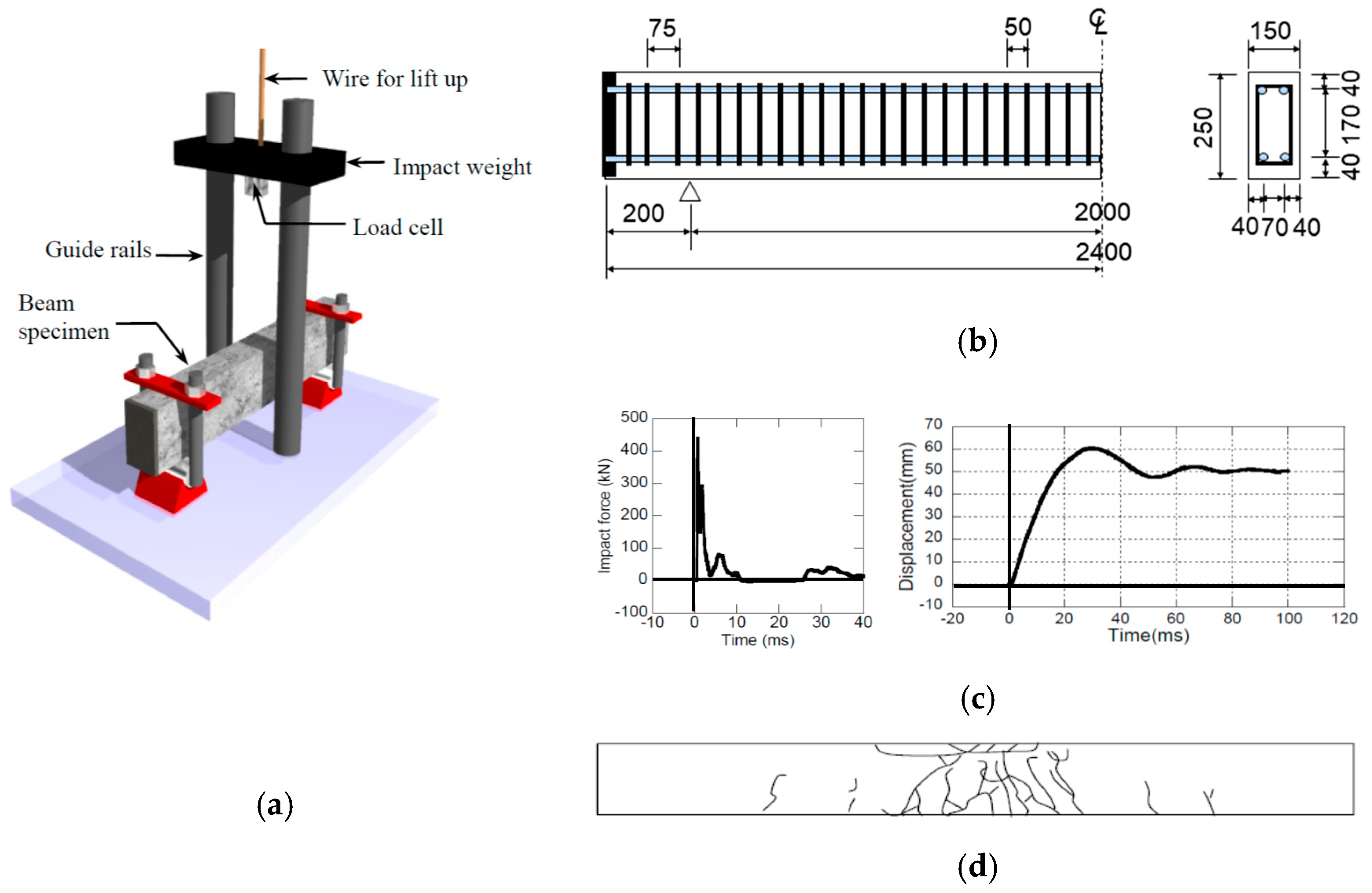

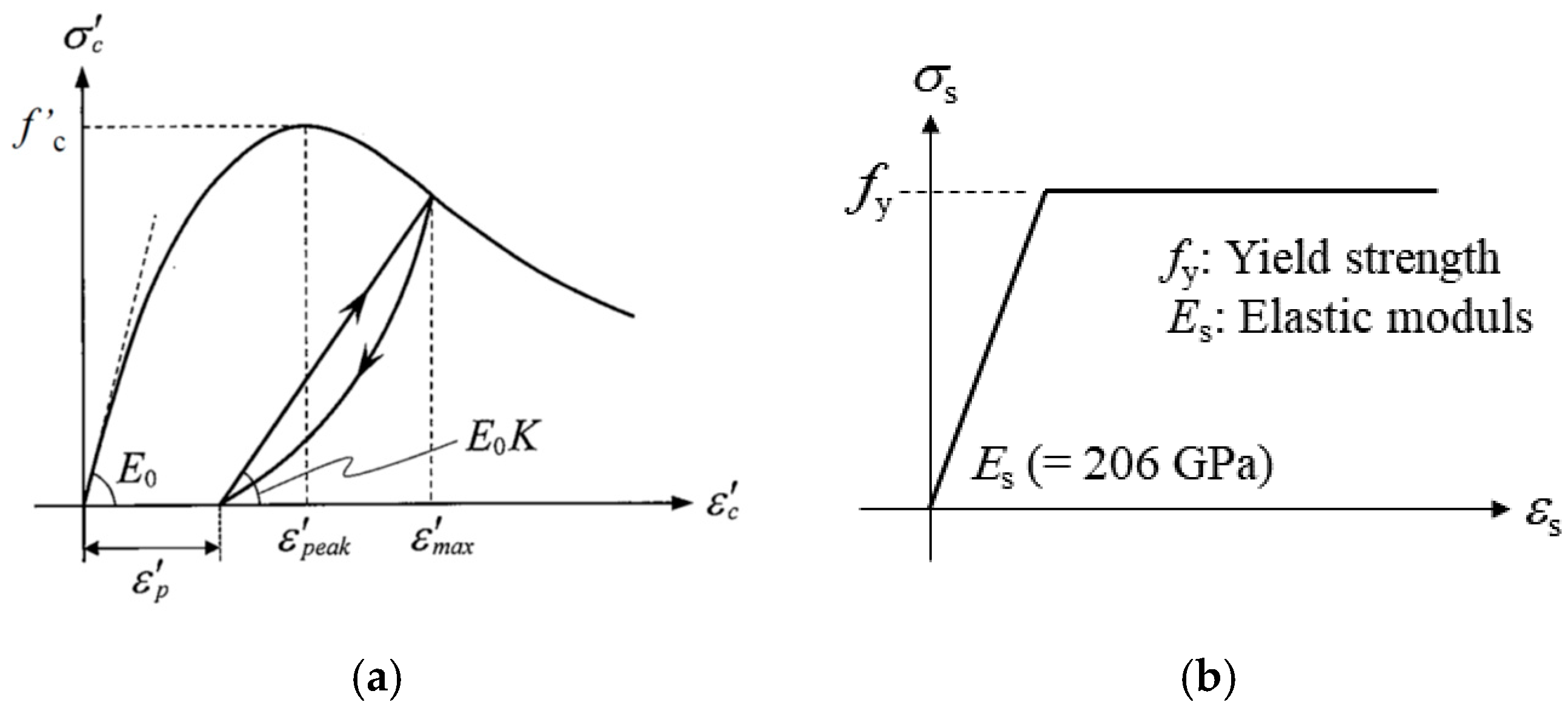

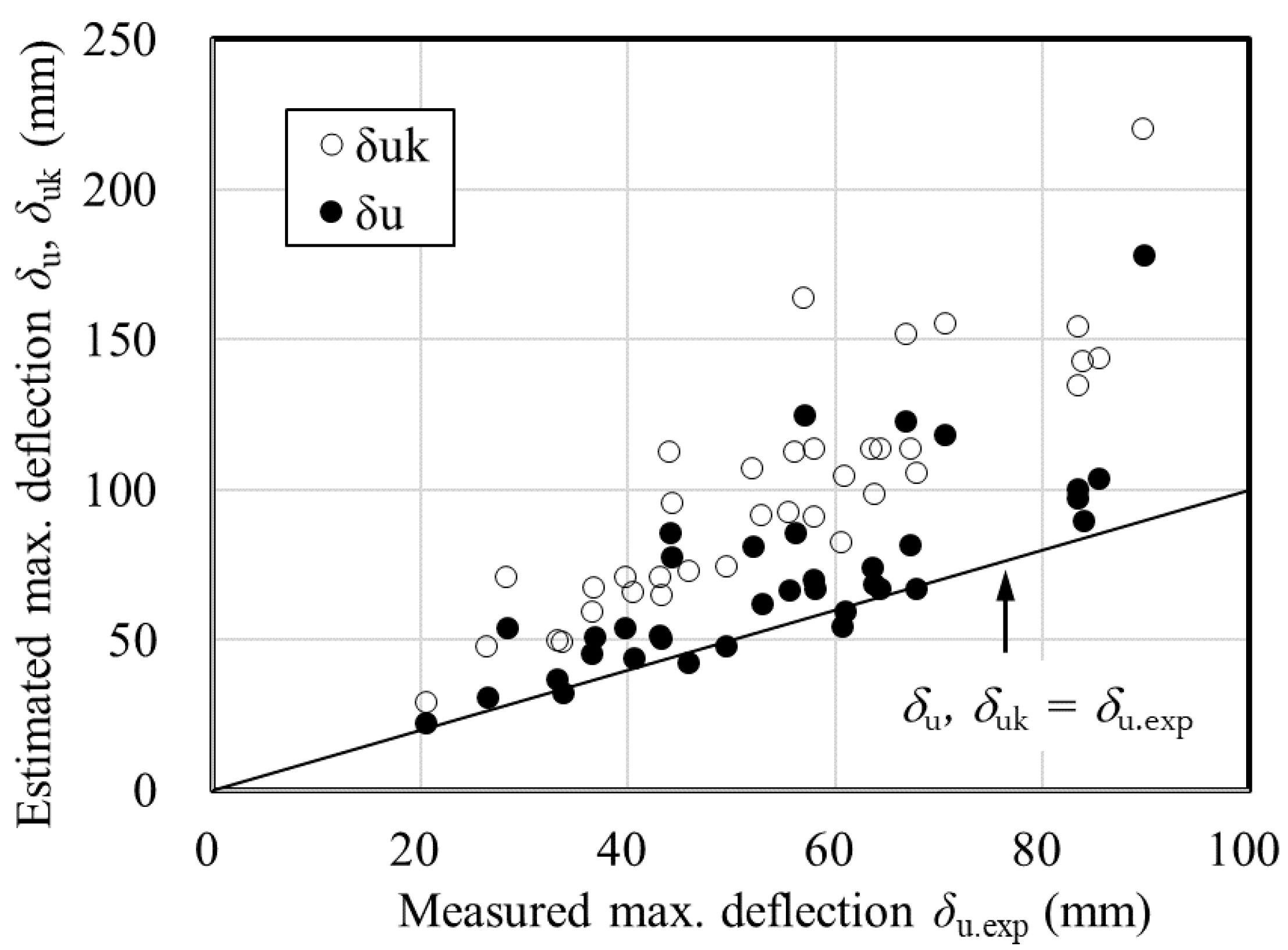
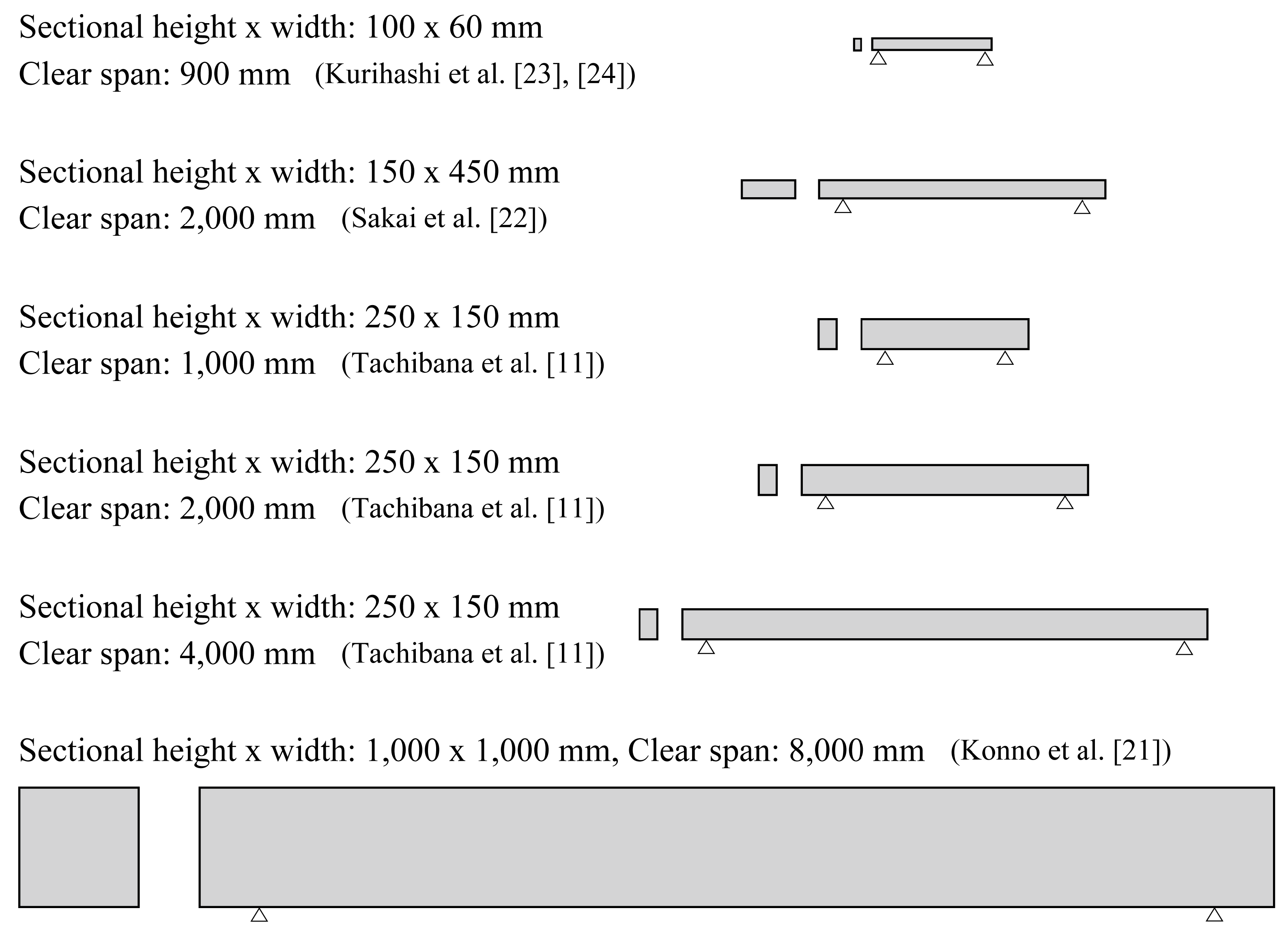
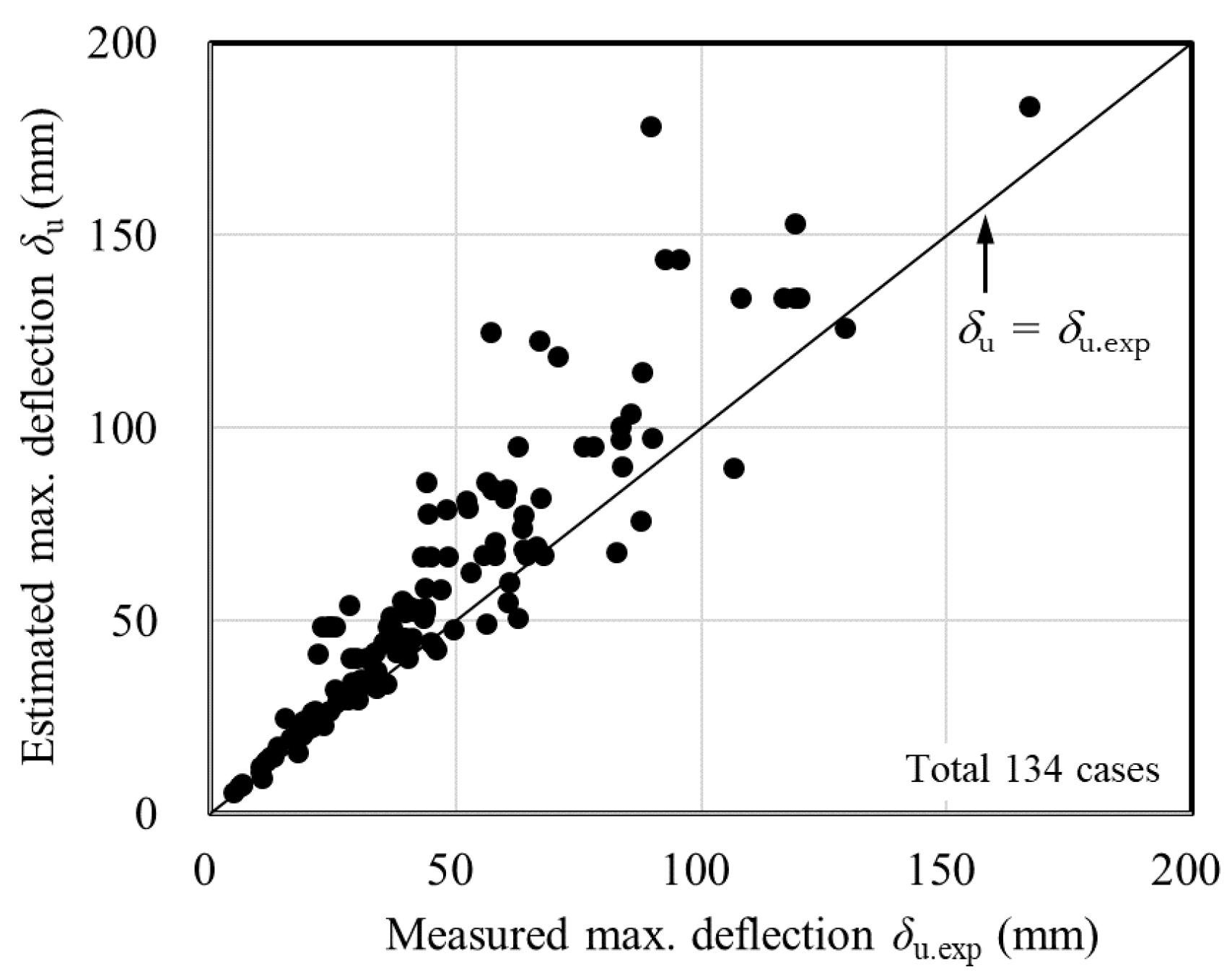
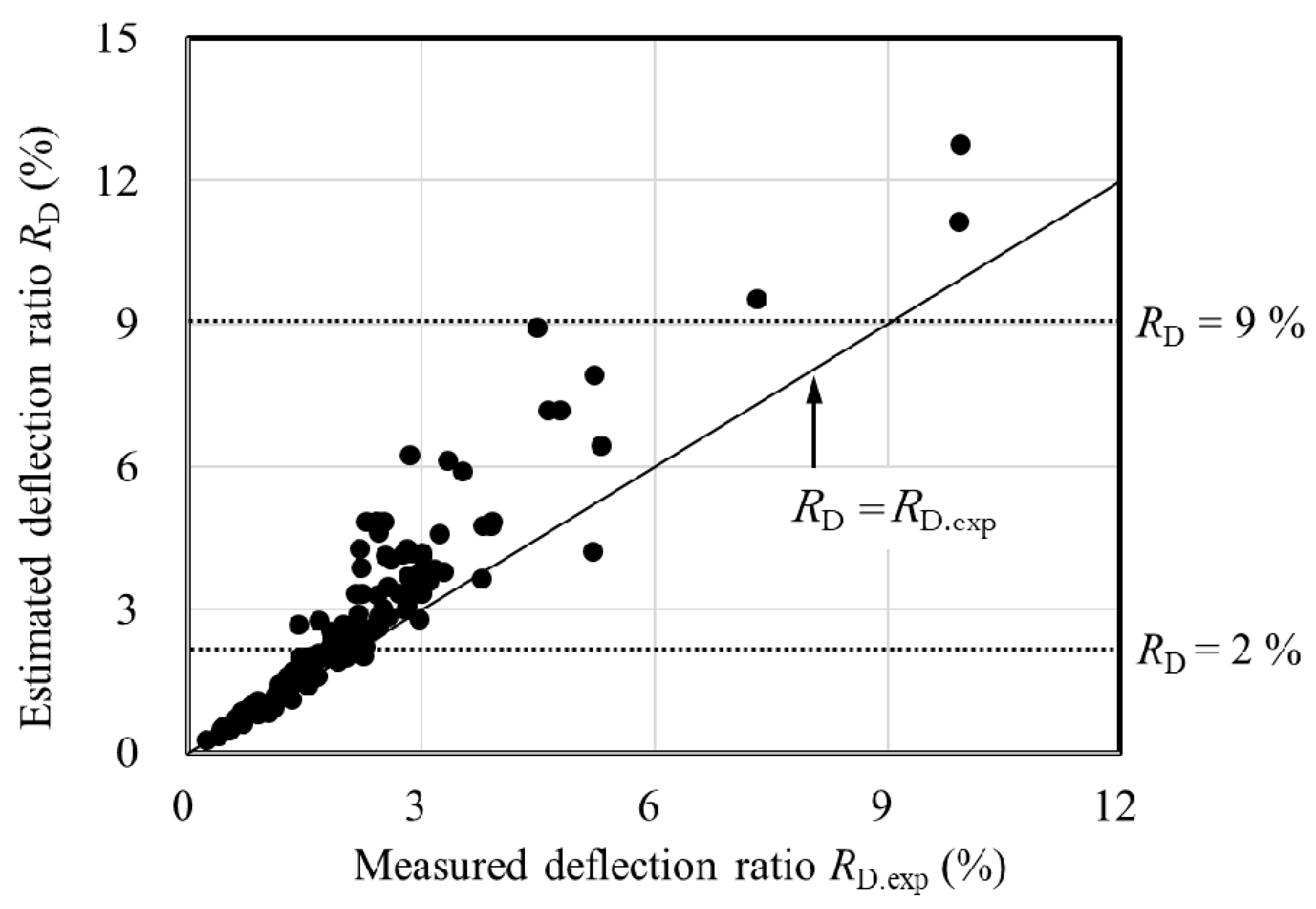
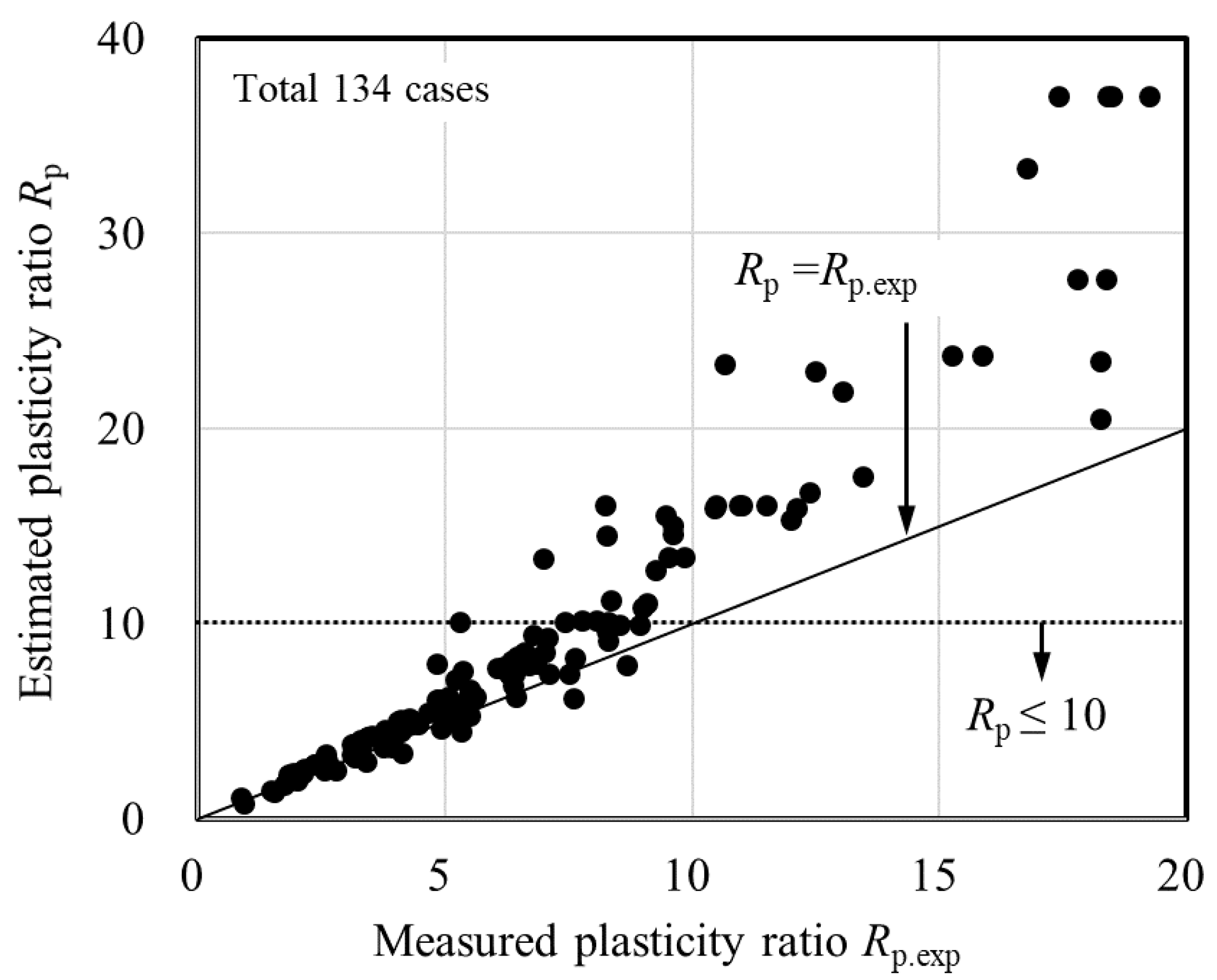
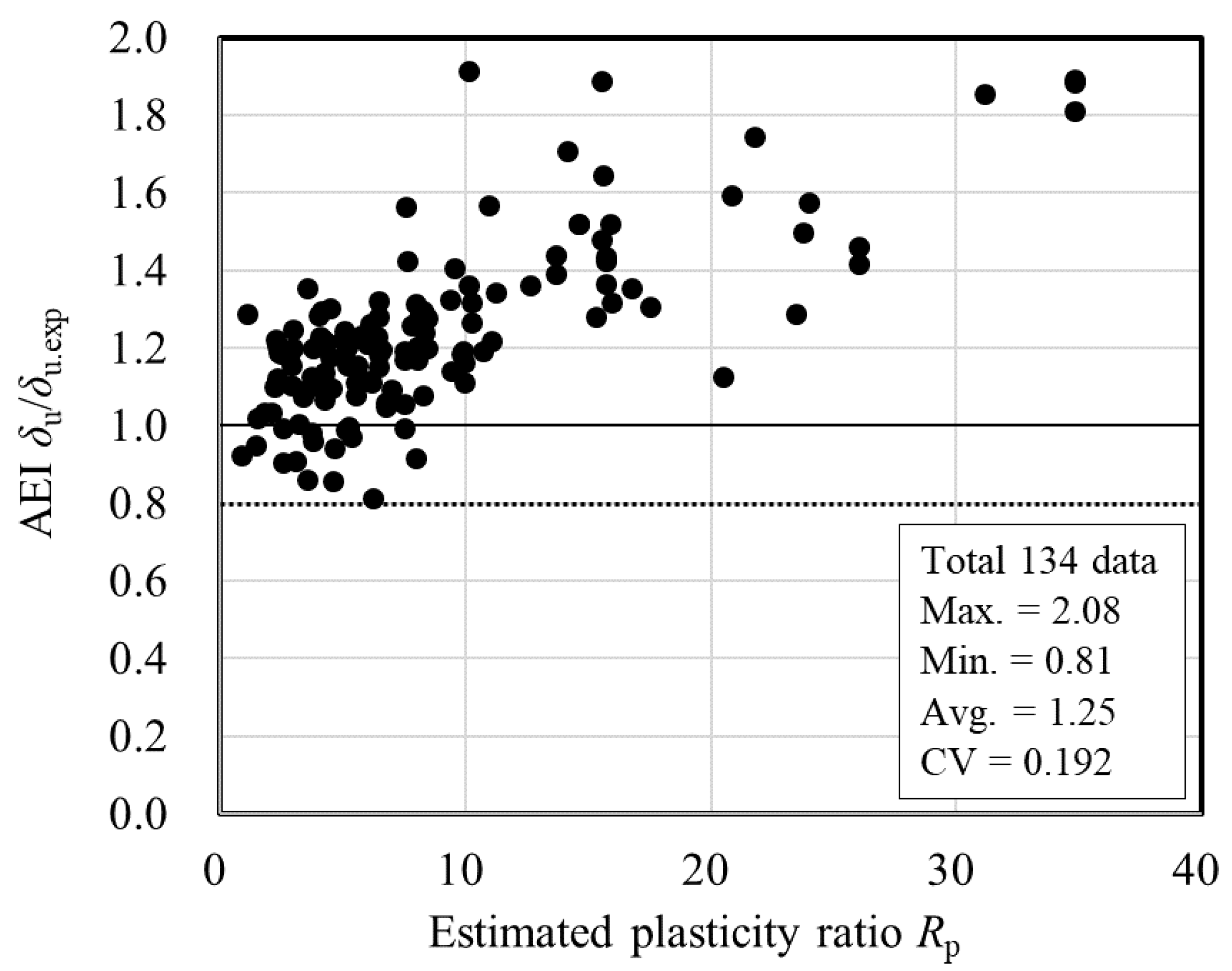
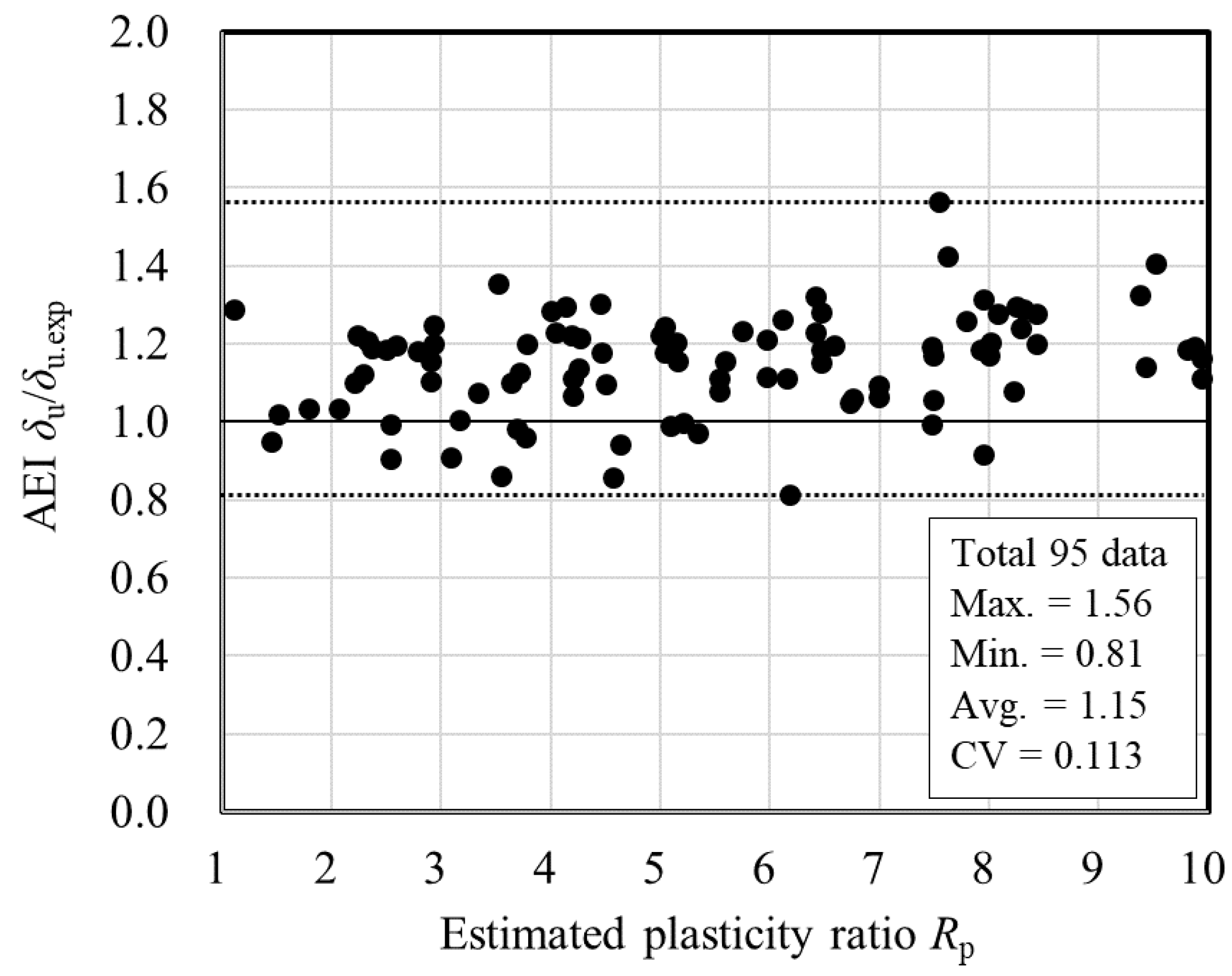
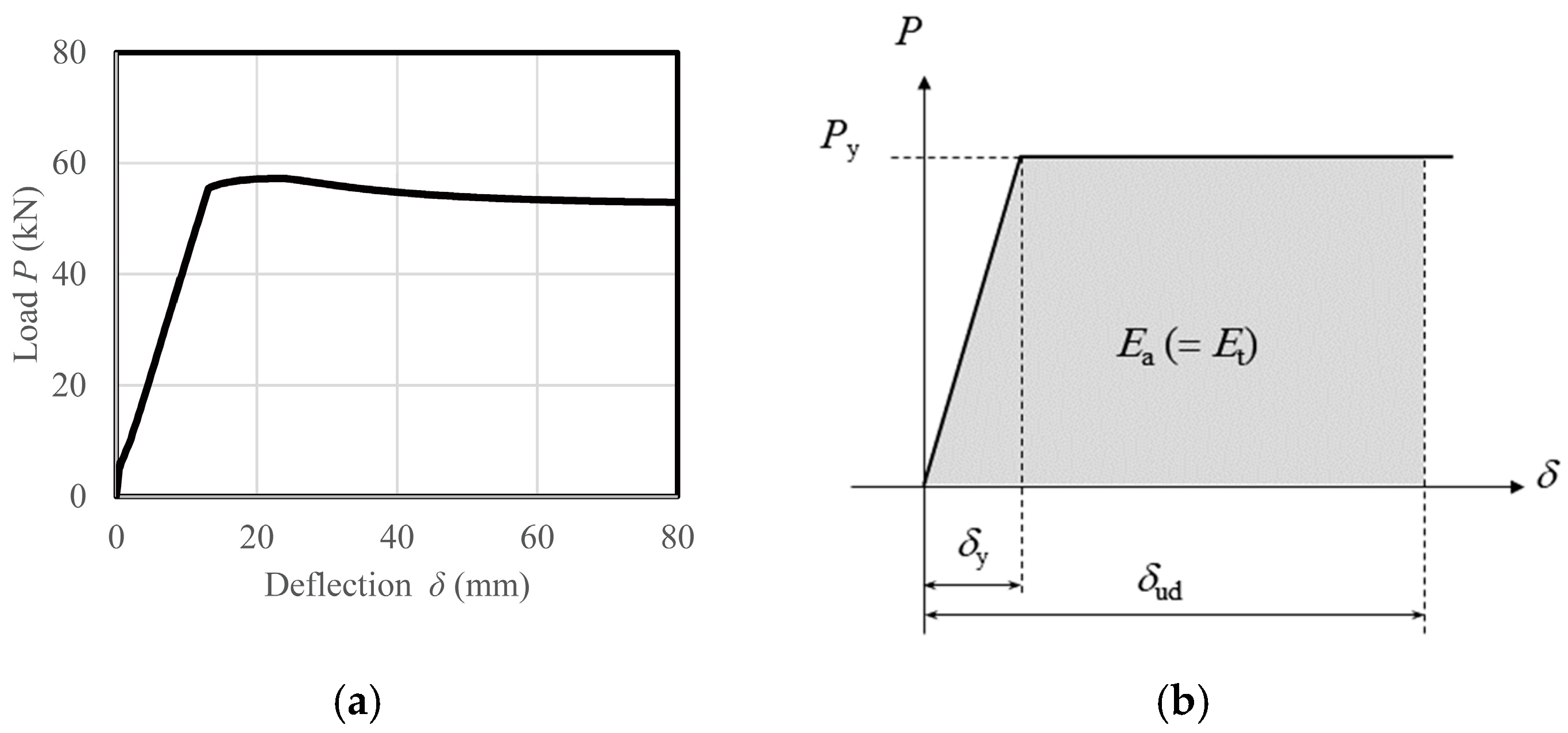
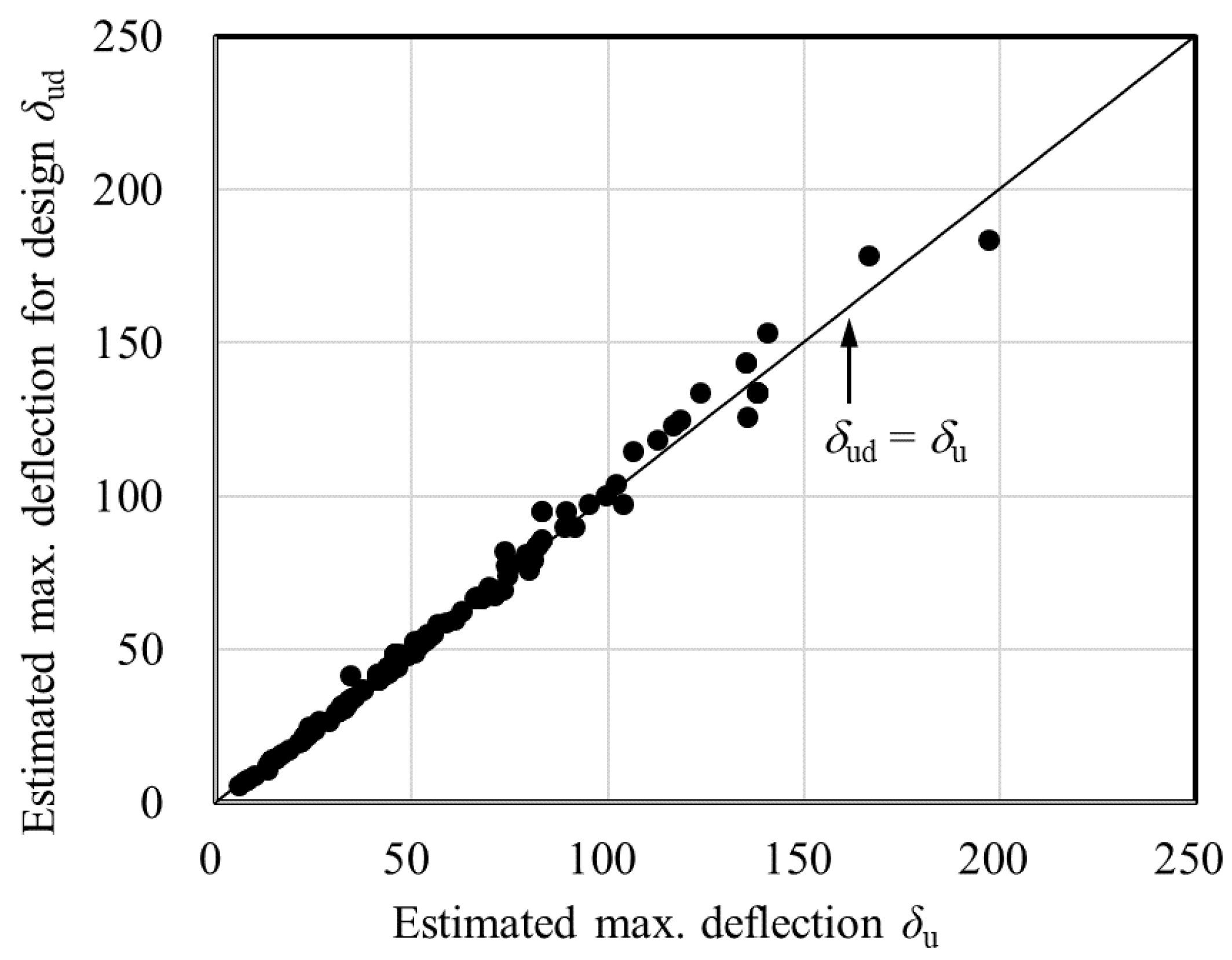
| Name | Size of Section | Rebar | L (m) | pt (%) | f’c (MPa) | fy (MPa) | Pu (kN) | Qu (kN) | α | Mb (t) | Mbe (t) | V (m/s) | Mw (t) | Ek (kJ) | Et (kJ) | |
|---|---|---|---|---|---|---|---|---|---|---|---|---|---|---|---|---|
| φ (mm) | N | |||||||||||||||
| G1-1 | 200 × 300 | 19 | 2 | 3.0 | 1.10 | 33.7 | 379 | 69.6 | 195.4 | 2.81 | 0.450 | 0.219 | 7.00 | 0.3 | 7.35 | 4.25 |
| G1-1S | 7.00 | 7.35 | 4.25 | |||||||||||||
| G2-1 | 150 × 250 | 13 | 2 | 2.0 | 0.80 | 32.2 | 373 | 38.1 | 139.7 | 3.67 | 0.188 | 0.091 | 4.00 | 0.3 | 2.40 | 1.84 |
| G2-2 | 5.00 | 3.75 | 2.88 | |||||||||||||
| G2-3 | 6.00 | 5.40 | 4.14 | |||||||||||||
| G2L-1 | 150 × 250 | 13 | 2 | 2.0 | 0.80 | 32.2 | 373 | 38.1 | 139.7 | 3.67 | 0.188 | 0.091 | 4.00 | 0.4 | 3.20 | 2.61 |
| G2L-2 | 5.00 | 5.00 | 4.07 | |||||||||||||
| G2L-3 | 6.00 | 7.20 | 5.86 | |||||||||||||
| G3-1 | 150 × 250 | 13 | 2 | 2.0 | 0.80 | 34.6 | 393 | 40.2 | 141.1 | 3.51 | 0.188 | 0.091 | 4.00 | 0.3 | 2.40 | 1.84 |
| G3-2 | 5.00 | 3.75 | 2.88 | |||||||||||||
| G3-3 | 6.00 | 5.40 | 4.14 | |||||||||||||
| G4-1 | 150 × 250 | 13 | 2 | 2.0 | 0.80 | 32.3 | 373 | 38.1 | 139.8 | 3.52 | 0.188 | 0.091 | 4.00 | 0.3 | 2.40 | 1.84 |
| G4-2 | 5.00 | 3.75 | 2.88 | |||||||||||||
| G5-1 | 200 × 300 | 19 | 2 | 3.0 | 1.10 | 39.2 | 379 | 70.4 | 200.4 | 2.85 | 0.450 | 0.219 | 6.00 | 0.4 | 7.20 | 4.66 |
| G5-2 | 7.00 | 9.80 | 6.34 | |||||||||||||
| G6-1 | 250 × 250 | 19 | 2 | 2.0 | 1.09 | 34.7 | 392 | 87.4 | 191.4 | 2.19 | 0.313 | 0.152 | 5.00 | 0.3 | 3.75 | 2.49 |
| G7-1 | 250 × 250 | 19 | 2 | 3.0 | 1.09 | 34.7 | 392 | 58.3 | 162.3 | 2.78 | 0.469 | 0.228 | 5.00 | 0.3 | 3.75 | 2.13 |
| G7-2 | 6.00 | 5.40 | 3.07 | |||||||||||||
| G8-1 | 200 × 200 | 25 | 2 | 2.0 | 3.17 | 34.7 | 383 | 102.3 | 158.4 | 1.55 | 0.200 | 0.097 | 6.00 | 0.3 | 5.40 | 4.08 |
| G9-1 | 200 × 200 | 25 | 2 | 3.0 | 3.17 | 34.7 | 383 | 68.2 | 136.3 | 2.00 | 0.200 | 0.097 | 5.00 | 0.3 | 3.75 | 2.83 |
| G9-2 | 6.00 | 5.40 | 4.08 | |||||||||||||
| G10-1 | 200 × 250 | 19 | 2 | 3.0 | 1.36 | 23.5 | 404 | 56.6 | 289.3 | 5.11 | 0.375 | 0.182 | 4.00 | 0.3 | 2.40 | 1.49 |
| G10-2 | 5.00 | 3.75 | 2.33 | |||||||||||||
| G10-3 | 6.00 | 5.40 | 3.36 | |||||||||||||
| G10-4 | 7.00 | 7.35 | 4.57 | |||||||||||||
| G11-1 | 200 × 300 | 22 | 2 | 2.7 | 1.55 | 23.6 | 401 | 94.4 | 164.8 | 1.66 | 0.405 | 0.197 | 3.13 | 0.5 | 2.45 | 1.76 |
| G11-2 | 4.20 | 4.41 | 3.16 | |||||||||||||
| G11-3 | 5.05 | 6.38 | 4.58 | |||||||||||||
| G11-4 | 5.78 | 8.35 | 5.99 | |||||||||||||
| G11-5 | 6.42 | 10.30 | 7.39 | |||||||||||||
| G11-6 | 7.00 | 12.25 | 8.79 | |||||||||||||
| G12-1 | 200 × 300 | 19 | 3 | 2.7 | 2.72 | 23.6 | 407 | 103.9 | 168.1 | 1.52 | 0.405 | 0.197 | 7.67 | 0.5 | 14.71 | 10.55 |
| G13-1 | 200 × 400 | 25 | 2 | 2.7 | 1.45 | 23.6 | 406 | 178.3 | 400.2 | 2.11 | 0.540 | 0.262 | 7.67 | 0.5 | 14.71 | 9.65 |
| G14-1 | 200 × 350 | 25 | 2 | 2.7 | 1.69 | 23.6 | 406 | 149.8 | 312.2 | 1.96 | 0.473 | 0.230 | 7.67 | 0.5 | 14.71 | 10.08 |
| G15-1 | 200 × 400 | 29 | 2 | 2.7 | 1.84 | 23.6 | 406 | 224 | 850.1 | 3.58 | 0.540 | 0.262 | 7.67 | 0.5 | 14.71 | 9.65 |
| G16-1 | 200 × 370 | 25 | 2 | 2.7 | 1.58 | 23.6 | 406 | 161.2 | 371.7 | 2.16 | 0.500 | 0.243 | 7.67 | 0.5 | 14.71 | 9.90 |
| Item of Specification | Symbol | Unit | Range of Value | |
|---|---|---|---|---|
| Min. | Max. | |||
| Size of section | mm | 60 × 100 | 1000 × 1,000 | |
| Clear span length | L | m | 0.9 | 8.0 |
| Tensile rebar ratio | pt | % | 0.26 | 1.26 |
| Compressive strength of concrete | f’c | MPa | 25.2 | 52.0 |
| Yield strength of the tensile rebar | fy | Mpa | 235 | 520 |
| Calculated bending capacity | Pu | kN | 4.10 | 881 |
| Calculated shear capacity | Qu | kN | 7.18 | 2,882 |
| Shear-bending capacity ratio | α | 1.19 | 8.78 | |
| Mass of beam | Mb | t | 0.014 | 20.0 |
| Mass of weight | Mw | t | 0.020 | 10.0 |
| Impact velocity of weight | V | m/s | 1.00 | 19.8 |
| The kinetic energy of weight (input energy) | Ek | kJ | 0.05 | 392.2 |
© 2020 by the authors. Licensee MDPI, Basel, Switzerland. This article is an open access article distributed under the terms and conditions of the Creative Commons Attribution (CC BY) license (http://creativecommons.org/licenses/by/4.0/).
Share and Cite
Kurihashi, Y.; Masuya, H. Simplified Estimation Method for Maximum Deflection in Bending-Failure-Type Reinforced Concrete Beams Subjected to Collision Action and Its Application Range. Appl. Sci. 2020, 10, 6941. https://doi.org/10.3390/app10196941
Kurihashi Y, Masuya H. Simplified Estimation Method for Maximum Deflection in Bending-Failure-Type Reinforced Concrete Beams Subjected to Collision Action and Its Application Range. Applied Sciences. 2020; 10(19):6941. https://doi.org/10.3390/app10196941
Chicago/Turabian StyleKurihashi, Yusuke, and Hiroshi Masuya. 2020. "Simplified Estimation Method for Maximum Deflection in Bending-Failure-Type Reinforced Concrete Beams Subjected to Collision Action and Its Application Range" Applied Sciences 10, no. 19: 6941. https://doi.org/10.3390/app10196941
APA StyleKurihashi, Y., & Masuya, H. (2020). Simplified Estimation Method for Maximum Deflection in Bending-Failure-Type Reinforced Concrete Beams Subjected to Collision Action and Its Application Range. Applied Sciences, 10(19), 6941. https://doi.org/10.3390/app10196941




